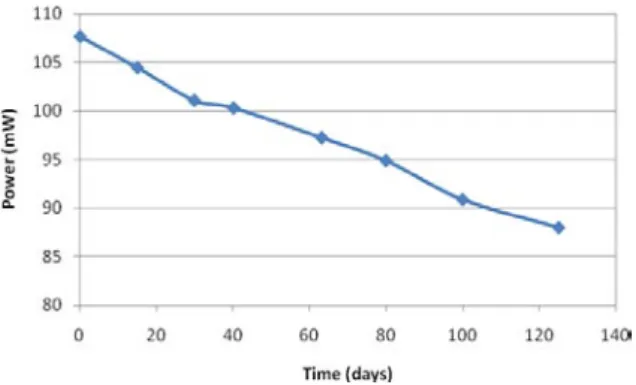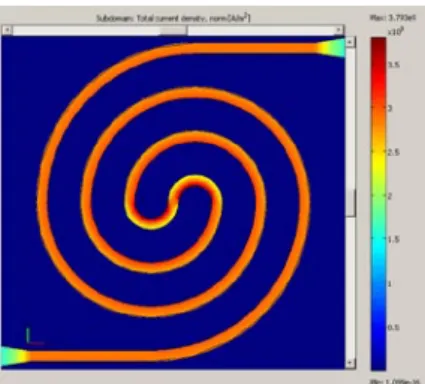HAL Id: hal-02099850
https://hal.laas.fr/hal-02099850
Submitted on 15 Apr 2019
HAL is a multi-disciplinary open access
archive for the deposit and dissemination of
sci-entific research documents, whether they are
pub-lished or not. The documents may come from
teaching and research institutions in France or
abroad, or from public or private research centers.
L’archive ouverte pluridisciplinaire HAL, est
destinée au dépôt et à la diffusion de documents
scientifiques de niveau recherche, publiés ou non,
émanant des établissements d’enseignement et de
recherche français ou étrangers, des laboratoires
publics ou privés.
High performances of new microhotplate for gas sensors
Philippe Menini, Habib Chalabi, P. Yoboué, E. Scheid, Véronique Conédéra,
Ludovic Salvagnac, Khalifa Aguir
To cite this version:
Philippe Menini, Habib Chalabi, P. Yoboué, E. Scheid, Véronique Conédéra, et al.. High
perfor-mances of new microhotplate for gas sensors. 22nd European Conference on Solid state Transducers
(EUROSENSORS XXII), Sep 2008, DRESDEN, Germany. �hal-02099850�
HIGH PERFORMANCES OF NEW MICROHOTPLATE FOR GAS SENSORS
Ph. Menini
1,2*, H. Chalabi
1, P. Yoboue
1, E. Scheid
1, V. Conedera
1, L. Salvagnac
1, K. Aguir
31
LAAS-CNRS, Université de Toulouse, 7 avenue du colonel Roche, F-31077 Toulouse, France
2
Université de Toulouse, Université Paul Sabatier, 118 route de Narbonne, F-31062 Toulouse, France
3
IM2NP-CNRS,Université Paul Cezanne, Av. Escadrille Normandie Niémen, F-13397 Marseille, France *Philippe Ménini, Tel: (+33) 5 61 33 62 18, Fax: (+33) 5 61 33 62 08, e-mail: menini@laas.fr
Abstract: The main goal of this work is to improve significantly performances of microhotplate for gas sensors. This article describes technological optimizations (materials and design) used to reach high and stable operating temperature, in reducing intrinsic drift problems (linked to standard polySilicon heater). Our heating platforms present low buckling effect, low consumption and good thermal homogeneity all over the active area. Keywords: Microtechnology, microhotplate, semi-conducting gas sensors.
INTRODUCTION
Presently semiconducting gas sensors are more and more attractive in a lot of fields of application, especially for automotive or environment to detect hazardous gases with a network of autonomous and distributed micro-sensors. Until day, industrialized and marketed micro gas sensors use polysilicon micro-hotplate but this technology drifts significantly with temperature, that induces drift of sensor sensitivity, and cannot definitively be used over 450°C without degradation as we can see on figure 1.
Figure 1. Time drift for 3 gas sensors using polysilicon technology
Basically, these sensors present a decrease of the power under constant voltage that corresponds to a drift of the heater resistance up to 15% after 125 days of using. This irreversible drift of the heater resistance yields to a decrease of the gas sensitivity.
Moreover, these sensors are still consuming too much power (>100 mW) for autonomous embedded systems.
The main goal of this work is firstly to improve the stability of our high operating temperature micro-hotplates based on platinum resistor in order to improve significantly semiconducting gas sensors performances [1].
SENSOR TECHNOLOGY
A first generation of microhotplate was conceived without any polysilicon resistor. This structure is
detailed in [1] ; the heater consists of a platinum resistor. The use of this material would have theoretical advantage to reach high level of temperature (around 650°C compare to 450°C with polycrystalline silicon). Finally, Pt-heater can be use such as a metallic thermistor in aimed to control more accurately sensitive layer temperature.
Figure 2. First generation of Microhotplate developed at CNRS-LAAS in collaboration with IM2NP.
This first generation of classical square-form closed membrane microhotplate has been achieved (fig. 2). It consists to silicon substrate with a 2µm-bi-layer SiO2-SiNx membrane on which are deposited
Ti/Pt heater, 0.7µm of PECVD SiO2 insulated layer,
interdigitated Ti/Pt electrodes and finally, the sensitive layer (50nm of sputtered WO3 elaborated
by IN2MP-CNRS or nanoparticular SnO2
synthetized by CNRS-LCC and deposited by microinjector). Finally, the last but not least step of the process is the backside releasing of the membrane by DRIE (Deep Reactive Ion Etching). A temperature sensor (platinum resistor) has been also integrated on the substrate.
Two different shapes of heaters (meander and spiral) have been investigated to try to optimize the yield (temperature vs. power) in taking the classical meandered form as reference. We studied three variants for every shape, making varying metallization length, width and fixed or variable spacing pitch. The table 1 summarizes the different structures.
Table 1: Different heaters studied Meander Spirale 2F Rh0 = 403 Ω 2C Rh0 = 463 Ω 2G Rh0 = 409 Ω 2D Rh0 = 541 Ω 2H Rh0 = 388 Ω 2E Rh0 = 382 Ω
Rh0 : Theoretical heater resistance at 20°C
The figure 3 presents an example of simulation results concerning 2 heater shapes in term of temperature profile according to x axis. The length explored corresponds to the active area (300 µm: center ±150 µm).
2F
2C
Figure 3: Example of Electro-thermal modelling results for two different heater resistor shapes: temperature
profile for Tmax=650°C
Even if the temperature profile of the spiral presents a hot spot at the centre of the membrane, the temperature gradient over the active area remains lower than the one of the heater with meander shape.
Regarding electro-thermal simulation results (from ANSYS software) about these heater resistor geometries, it clearly appears from figure 4 that it is possible to improve significantly the homogeneity for one hand in keeping power consumption at the same level (around 60 mW for 600°C).
In this article, the homogeneity criteria have been defined by:
H%=S(∆Τ<40) / Sa (1)
Where
S(∆T<40) corresponds to the surface area where the temperature gradient is lower than 40°C (∆T<40°C) and Sa :Active surface area (surface occupied by
the sensitive layer).
Figure 4. Example of Electro-thermal modelling results for two different heater resistor shapes : Power consumption and Homogeneity rate for Tmax =650°C
Considering these results, we adopted the double spiraled form with variable pitch 2C [2]. Indeed this form presents the better compromise between the thermal homogeneity through sensitive layer and power consumption. Infrared measurements show that our platform can reach 600°C with low thermal inertia (≈10ms only) that allows very fast operating temperature changing. However for a stable thermal behavior it is necessary to limit temperature at 550°C due to titanium diffusion at higher temperature [3].
More precise simulations have been realised to analyse local joule effect in the heater. Figure 5 shows clearly that the current density is more important in angles than in the rest of metal. That leads a joule effect more important in angles and can degrade locally the heater. It also could be a cause of long term heater resistance drift or irreversible degradation.
Figure 5: Example of Electro-thermal modelling results for two different heater resistor shapes: local joule effects
OPTIMIZATIONS
Today, a new microhotplate has been elaborated integrating design and technology modifications (fig. 6b) in order to improve significantly its performances in term of mechanical deformation, temperature homogeneity, power consumption, and long term stability at high operating temperature.
a)
b)
Figure 6: a) Previous structure; b) New micro hotplate developed at CNRS-LAAS.
Firstly, concerning mechanical reliability, the initial 2µm-square membrane was replaced by a rounded thinner one of 1.4 µm (SiO2/SiNX-0.8/0.6µm) to
decrease the thermal inertia and to minimize intrinsic mechanical constraints. Indeed, the maximal deflection of the first generation structure (fig.6a) was about 8µm at rest with nonlinear variations of several µm (≈5-10µm) at higher operating temperatures. In other side, the new generation enabled to reduce the deflection around 0.5µm only with low variations in functioning (some hundred of nm) as it is shown in fig. 7.
The shape of the membrane contributes to minimize these deformations: the circular membrane has uniform concentric deformations contrary to square membrane which has a cross shape deformation (fig.6a) due to the angles in accordance with literature [4]. In addition, it should be noted that these results have been obtained with complete structure including all metalized layers (very stressed) and validated in the total operating temperature range.
These optimizations concerning the membrane are really important for gas sensors used with pulsed temperature in term of reliability of the hotplate but also of the sensitive layer (adherence and morphology).
In a second hand, concerning power consumption, this micro hotplate can easily reach 600°C with only 70mW. It can be firstly seen in fig. 8 that new experimental thermal measurements with infrared camera are in good accordance with numerical simulation results (now obtained with Comsol multiphysics software). Secondly, it clearly appears that the new structure permits to decrease the power of 30% for a given target temperature.
a)
b)
Figure 7: Measurements of membrane deformations from optical profiler: a) example of membrane profile ; b) maximal deflection for different heater voltages (i.e. for
different temperatures)
Figure 8: Comparison between experience and electro-thermal modelling results with Comsol Mutiphysics for
the new heater resistor; comparison also with the previous microhotplate performances
X-axis
With this microhotplate structure, the absence of angles minimized local joule effects. In figure 9, current density is important and homogeneous along shorts streamlines (centre of heater).
Figure 9: Electro-thermal modelling results with Comsol Multiphysics: local joule effects
Concerning the temperature homogeneity, simulation and experimental results carried out very interesting performance with a maximum gradient in the range of ±20°C on a 160µm-diameter active area centred with heater (at 67mW) (fig.10).
Figure 10: Electro-thermal modelling results : temperature profile through x axis
Finally, concerning the ageing of the heater, we observed, after two months powered by constant voltage, the very good stability of this structure contrary to polysilicon heater that always drifts at 450°C.
Figure 11: Ageing of heaters at different voltage supplies
It can be seen on fig. 11 that the heater resistance remains stable for supply voltages lower than 7V that corresponds to 67mW (565°C). For higher supply voltage (8V), it can be observed an irreversible ageing (during approximately 20 days) before stabilization.
CONCLUSION
This article presents technological optimizations of a micro hotplate based on Ti/Pt heater. The objective was to improve performances in term of mechanical deformation, temperature homogeneity, power consumption, and long term stability at high operating temperature.
Our first results showed that the characteristics are stable until 550°C. That corresponds to a great improvement compared to the structure using the poly-silicon. Above this temperature, this kind of metallization is well known to be unusable because of titanium diffusion and oxidation. The second generation enables to reduce the power consumption of 30% and the maximal deflection by a factor 10. All these improvements are suitable for reliable gas sensors.
Moreover, we are now working to increase integration of different sensitive layers by adding removable micro-cavity: sputtered WO3 thin films
[6] or colloidal SnO2 [7] are example of sensing
material in way of multisensors.
REFERENCES
1. H. Chalabi et al, Development of Integrated Smart Nose Based on WO3 Gas Sensors, Eurosensors XX,
Göteborg, 2006, proc. pp 112-113.
2. M. Baroncini et al, Thermal characterization of a micro heater for micromachined gas sensors,Sensors
and Actuators A, 115, 2004, pp8-14.
3. H. Esch et al, The stability of Pt heater and temperature sensing elements for silicon integrated tin oxide gas sensors, Sensors and Actuators B, 65, 2000, pp190-192.
4. X. Chauffleur et al., Thermal drifts due to thermomechanical deformations in capacitive pressure sensors, EurosensorsXII, Southampton, 13-16 Septembre 1998, Vol.1, pp.411-414
5. J. Puigcorbé and al., High temperature degradation of Pt/Ti electrodes in micro-hotplate gas sensors, J. of Micromechanics and Microengineering, 13 (2003), pp 119-124.
6. K. Aguir et al, Electrical properties of reactively sputtered WO3… Sensors and Actuators B, 84,
2002, pp1-5.
7. L. Erades et al, Organometallic approach for platinium and palladium doping of tin and tin oxide nanoparticles : structural characterization and gas sensor investigations
New Journal of Chemistry, 2006, 30, pp1026-1035. Active Area



